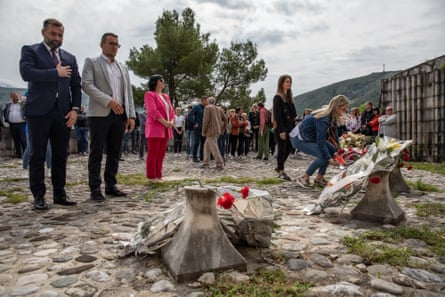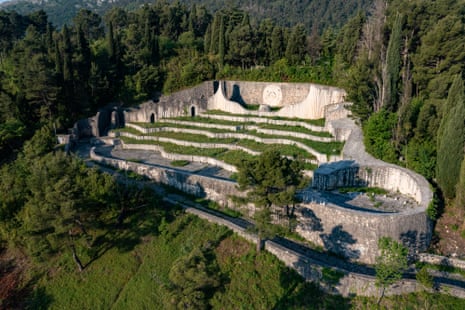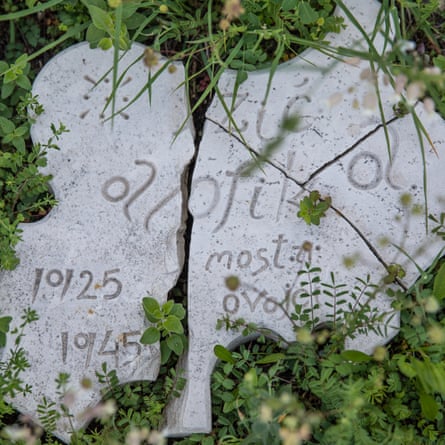Mostar is the bucket-list city for every tourist to Bosnia and Herzegovina. Its Old Town features pre-Ottoman, eastern Ottoman, Mediterranean and western European architectural features and the rebuilt Unesco-designated Old Bridge that dates back to 1459. Every spring and summer the Old Town is visited by tens of thousands of day-tripper tourists and backpackers, yet only 10 minutes away, on the west side of the city, is another equally important historical landmark that sits abandoned and partially destroyed, where few tourists ever venture.

Built between 1959 and 1965, the Partisan Memorial Cemetery is a park dedicated to those who died fighting as Yugoslav partisans against the Independent State of Croatia – a puppet state of Nazi Germany and fascist Italy. Built and designed by the renowned architect Bogdan Bogdanović, it is listed as a national monument and was once labelled as the crown jewel of Mostar.

-
The well at the top of the memorial park was once part of a design in which water flowed through the site, mimicking the Neretva River that flows through Mostar and symbolising the tears of the young partisan fighters
Bogdanović was commissioned to design dozens of monuments and memorials across Yugoslavia after the second world war. His memorials would blend into the landscape, sometimes taking over and becoming the landscape itself. His underlying message in all his work was “life overcomes death”; his structures were conceived as public parks, sites of everyday life that bring the living and the dead together.


Bogdanović combined his formative experiences of surrealism with architectural history and anthropology to create abstract memorials of allusive organic shapes with references to the cosmos and the future. Each of his monuments was built with the intention of marking a shared start among all the ethnic groups that made up Yugoslavia. The Partisan Memorial Cemetery was his most renowned and prominent design, a hillside landscape explicitly conceived as a “city of the dead” facing the “city of the living” to remind Mostar of the sacrifices made.

During the second world war Mostar was known as the Red City because of its particularly strong resistance, carried out by fighters who were Serbian, Croatian, Muslim, Jewish and other ethnicities. Most of the partisans who died in the cause were very young, and they are memorialised on stones designed as chopped-down trees to symbolise fallen youth.

-
Edita Vučić, a cultural heritage professor, regularly takes her students to the partisan cemetery. Many of them have never visited it before
In March 1992, a grenade was set off in the cemetery and the sound echoed across the city as a warning, marking the oncoming Bosnian war, a war that would ravage and divide the city of Mostar once more. Thirty years after the fighting ended, the city remains divided. And like Mostar, the necropolis divides opinion and has become a bitter ideological battleground.
Sead Đulić, a theatre director and head of the national Association of Anti-Fascists, is always first in line to defend the site. He argues the necropolis is more than a cemetery: “This is our Statue of Liberty, our triumphal arch, our Taj Mahal. It is a celebration of life and Mostar. It was built as a city of the dead mirroring the city of the living for a city that lost so much.”

-
Sead Đulić, a theatre director and head of the national Association of Anti-Fascists, paints over derogatory graffiti about Tito, the leader of Yugoslavia from 1945 to 1980
Today very few residents of Mostar visit, complaining that the site is overrun by youths drinking and taking drugs and is a general eyesore. Some residents and politicians would prefer the memorial park to disappear, claiming it is a communist relic from the past and not part of “their history”. When Đulić and other anti-fascists visit the site to lay flowers they need police protection, as there have been clashes with rightwing groups on commemoration days. “It can be dangerous to even talk about the necropolis now, never mind visit it,’ he explains.




-
Memorial stones with the name, age and place of birth and death of the partisan fighters. The stones were designed as chopped-down trees to symbolise fallen youth, as most of the fighters were 18 to 25 years old. In June 2022, many of the 700 stones were smashed overnight in a planned and systematic attack
In the past few years, neofascists have been gradually vandalising the site with swastikas and symbols of Ustaša – the Croatian Nazi puppet state during the second world war. The Croatian Catholic church has also taken sides, alleging that the land where the partisan cemetery sits was wrongly taken from them in the late 1960s and denying that there are any human remains on the site.

The most recent full-scale attack on the cemetery was in June 2022, when hundreds of stone flowers that bore the names of the anti-fascist fighters, their places of birth, and the places and years in which they were executed, were smashed to pieces. Swastikas were spray-painted on the entrance pillars. The mayor of Mostar, Mario Kordić, refutes the claim that the attacks were organised by local fascist groups and instead blames the vandalism on individuals. Local police said there were no witnesses, so they were unable to investigate the June 2022 attack. Some in the city claim the police’s inaction is part of the problem and evidence of wider political forces at play.

-
The mayor of Mostar, Mario Kordić, says the destruction of the memorial cemetery and the spray-painted swastikas was the work of individuals, not any organised Croatian rightwing groups
A small group of residents, architects and activists in Mostar are now fighting to protect the necropolis and its history for future generations. In March 2023, local architect Senada Demirović and her organisation Urban House IDEAA successfully pitched for the Partisan Memorial Cemetery to be listed among the cultural heritage group Europa Nostra’s seven most endangered monuments and heritage sites in Europe as a last-minute attempt to attract international attention and possible rescue. However, faced with a lack of political will and funding, difficult living conditions across Bosnia and Herzegovina after the 1990s war and fear of intimidation in a divided city, the cemetery’s defenders face an uphill struggle.

-
Marina Mimoza, a local artist and the director of the Rezon street art festival in Mostar, holds one of the broken memorial stones
Marina Mimoza, a local artist, wants to separate the site from the politics. She views the memorial cemetery simply as one of the greatest works of land art in the country. As part of her installation, she lights up the site at night with candles. She says: “I always view this place outside of a political context. I wanted to do something simple and spontaneous with light – to remind the people of Mostar of the beauty of this place.”

This project was funded by the Pulitzer Center and supported by local partners the Post-Conflict Research Center. A documentary film by Chris Leslie on the Partisan Memorial Cemetery is in progress.

